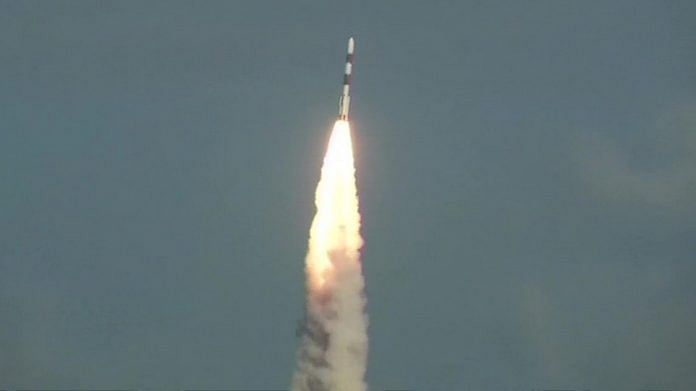Bengaluru: The Indian Space Research Organisation (ISRO) successfully launched the indigenous RISAT-2BR1 satellite and nine other commercial payloads through its PSLV-C48 mission from the Satish Dhawan Space Centre at Sriharikota at 3.25 pm Wednesday.
The RISAT-2BR1 is a defence-grade satellite that will enhance India’s surveillance capabilities. It is a radar satellite and the fourth in India’s RISAT series.
The nine customer satellites are from companies based out of Japan (1), Italy (1), Israel (1) and the US (6), whose rides were arranged under a commercial agreement with NewSpace India Limited (NSIL).
The mission is the reliable and cost-effective PSLV launcher’s 50th mission, marking a milestone in ISRO’s space activities. It was launched in the rocket’s QL variation with four strap-on motors.
Also read: Why ISRO’s Cartosat-3 is most complex and advanced satellite India has built
Radar eye in the sky
The RISAT-2BR1, a 628 kg-radar imaging satellite, was placed in an orbit of 576 km above Earth. As radar satellites go, this one will function in all weather conditions and can penetrate cloud cover as well as darkness. It can also observe through all kinds of terrain.
The RISAT series has the objective of also monitoring terrorist activities. RISAT-2 was launched immediately after the 2008 Mumbai attacks and before the RISAT-1 satellite, which wasn’t ready in time. The satellite has a 0.35m resolution, which means it can make out objects separated by that distance and covers a swath of 5 to 10 km as it moves around Earth.
Synthetic Aperture Radar that is used in the satellite will function on the X-band through a 3.6-metre mesh antenna. It can obtain radar imagery of a location from multiple angles and construct three-dimensional images. The angle at which it is placed is 37 degrees to the equator, enabling it to focus on the subcontinent.
Also read: Astronomers observe strongest gamma ray bursts — explosions with more energy than ever
Satellite will ensure high-resolution reconstruction
The satellite will transmit a series of radio waves, which reach a target and bounce off it, back to the satellite. Since the satellite is moving in space, the transmitted pulses hit the target at different angles. All the reflected signals (called ‘echoes’) from the different antenna positions are then combined to form a high-resolution reconstruction.
In the case of military reconnaissance, if a target is moving, the echoes reflected back are shifted in frequency, much like the Doppler Effect. This enables the recipient to infer details about the speed and direction of motion of the target.
Such imaging and reconstruction finds a wide variety of applications, including geology, change in terrain; sub-surface imaging, as radar can often penetrate the ground; glaciology, to measure ice thickness and growth; volcano and earthquake monitoring; deforestation; crop growth and yield; monitoring oil spills; recording growth of civil infrastructure apart from military surveillance.
For a major part, apart from assistance to the military, the satellite will also monitor weather, agriculture, forest cover, and aid in disaster management.
The satellite is expected to function for at least five years. As with all space missions, it will likely function for a lot longer than the designated minimum duration.
Also read: Discovery of water on moon: What India’s first Chandrayaan mission achieved a decade ago



